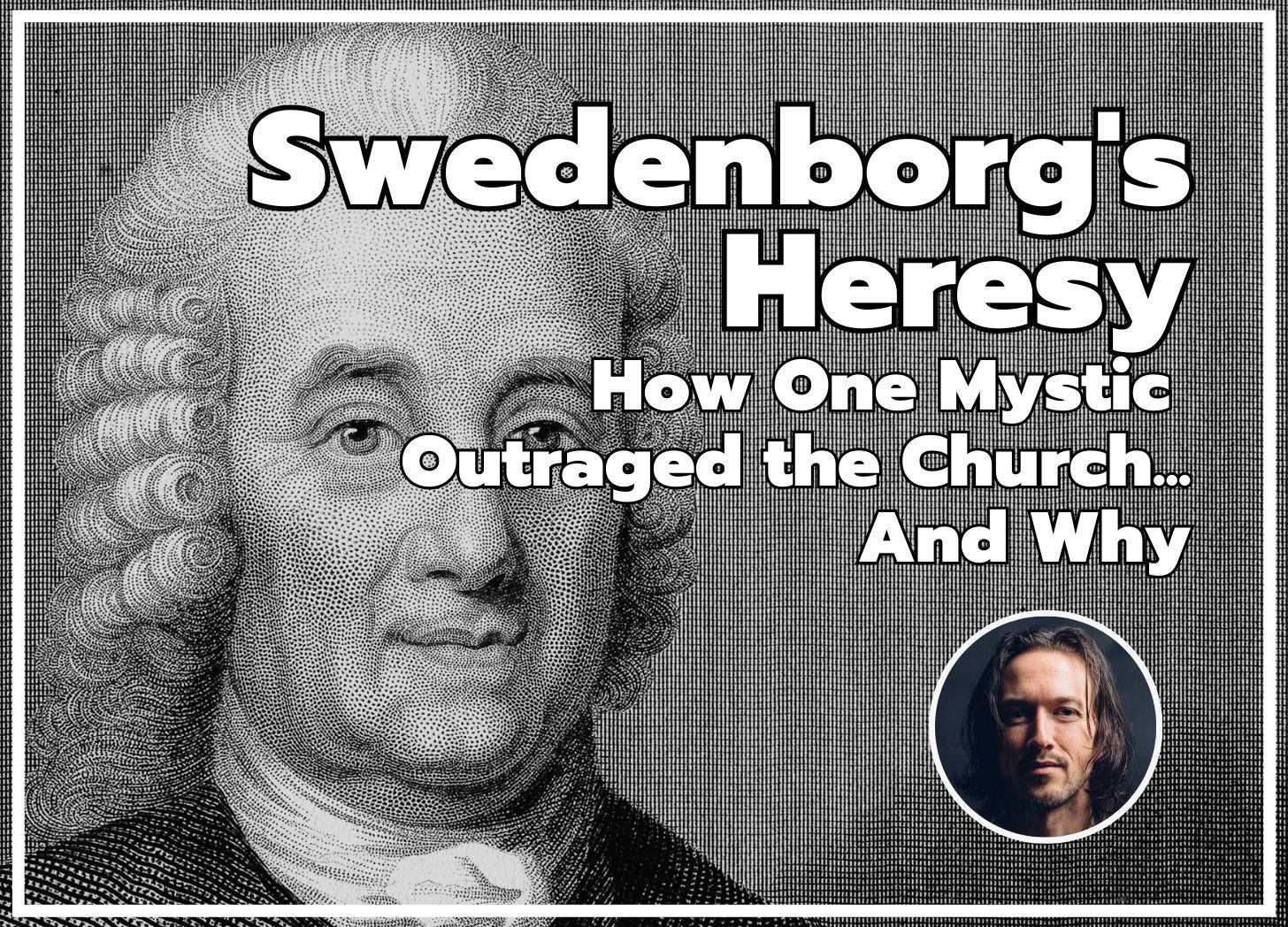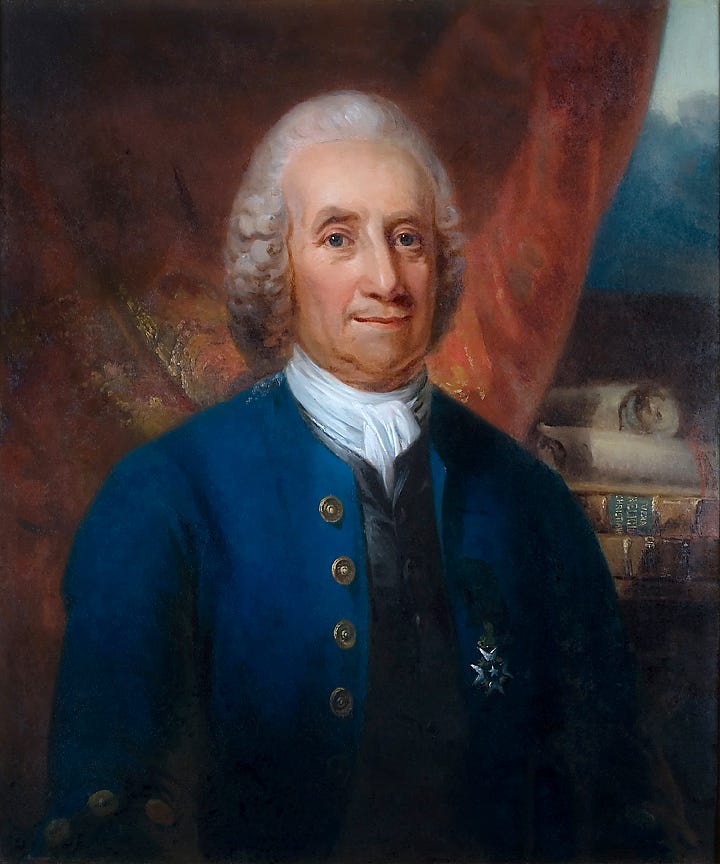Swedenborg's Heresy
How One Mystic Outraged the Church... and Why
Thanks for reading, fellow metahuman and unconventional critical thinker! 🧐
This is an audience-supported publication AND a powerful podcast, producing uncommon insight. Here are some handy ways you can support me ⤵️
Share with your networks ♻️
Become a valued paid subscriber and get full Substack access 24/7
Buy my first book, THE GRAND ILLUSION: A SYNTHESIS OF SCIENCE & SPIRITUALITY 📕
🌶 Get EVERYTHING I do: Join ‘The Truthiversity - The #1 consciousness-raising university’ and get my articles AND all my premium content (including audio versions and full podcasts) for the price of barely three coffees a month! ☕️ (It’s better for your health)
Researching, educating, and helping people transform their lives is what I do full-time, so thanks in advance for your support - it means a lot! 👊🏼
-Brendan
Emmanuel Swedenborg, an 17th-century Swedish polymath, was a figure whose life and work left an indelible mark on the realms of spirituality, philosophy, and mysticism. Born on January 29, 1688, in Stockholm, Swedenborg initially gained recognition as a scientist, engineer, and inventor, making significant contributions to various fields such as metallurgy and crystallography.
However, it was his profound spiritual experiences that catapulted him into the realm of mysticism and made him one of the most compelling figures of his time, one whose works and insights resonated all the way into the 21st century.
Around the age of 56, Swedenborg began to report vivid visions and encounters with angels, demons, and spirits from other realms. These mystical experiences formed the basis of his groundbreaking theological and spiritual writings, including works like "Heaven and Hell" and "The Divine Love and Wisdom."
Swedenborg claimed that he had been granted access to the spiritual world, providing detailed insights into the afterlife, the nature of God, and the interconnectedness of the spiritual and material realms. His teachings merged Christian theology with a unique cosmology, influencing a diverse range of thinkers, from poets like Blake to philosophers such as Kant.
The combination of Swedenborg's scientific background, compelling personal experiences, and profound spiritual insights made him a captivating and enigmatic figure—one who happened to make the church hierarchy of his time a little less than totally comfortable...
A Heretical Thorn in Orthodoxy’s Side
One of the most contentious aspects of Swedenborg's theology was his rejection of the orthodox concept of the Trinity. He argued that the Father, Son, and Holy Spirit were not distinct persons within a single Godhead but rather different aspects of one divine being. This indicates a supramental or “mystical” level of insight on the Swede’s part—something the Church was never overly fond of.
This departure from accepted Trinitarian doctrine provoked strong opposition from the Church, leading to accusations of—gasp!—heresy.
(Burn the witch!)
To make matters worse, Swedenborg's ideas about the afterlife were equally unconventional. He described a complex spiritual world with multiple heavens and hells (something the Hindus and Buddhists had already discerned centuries prior), suggesting a more nuanced and individualized system of “salvation” than the traditional exoteric Christian understanding.
These teachings only fueled the perception that Swedenborg's mystical experiences were undermining established religious authority (and we can’t have that, can we!).
Swedenborg’s clairvoyance and visionary experiences allowed his mind access to information most humans of his era were simply not privy to—the majority of believers just believed in the Church-approved words on a page. They weren’t able to empirically test the ideas through direct experience.
Regarding eschatology and the hereafter, there were a number of key areas in which the Christian mystic departed from Church doctrine:
1. He stated there was only a thin veil separating “heaven” and earth.
(Accurate: an alteration of consciousness is all it takes to make the transition from the Kenoma/physical-matter-orientation into the imaginal realm or pleroma; the non-physical worlds superposed over the physical. Readers of my first book know this is indisputable. Book 2 will take us far deeper into the “other side.”)
2. He described life in the heaven worlds in similar terms to earth life: they would be of a “tangible” material character but in spiritualised form. People did not undergo a radical transformation and their basic sensory capacities continued to function without the physical body. The afterlife Swedenborg saw featured cities, houses, parks, gardens and people going about fairly ordinary earth-like activities.
(Accurate in so far as the lower heaven realms do possess form [rupa], and people’s personalities do remain basically the same. The mid- to upper-astral planes do indeed feature the elements Swedenborg reported. They are essentially apotheotic versions of familiar earth life.)
3. Heaven was just a stage in the spiritual journey, not the final resting place of what had become Christian theology. Here people would be engaged in worthy activities that would bring them closer to “God,” which was not a person, but the love-filled foundation of existence.
(Also accurate, as far as the lower heaven worlds of form-having “astral” and “mental planes” go. I’ll elaborate on these ideas in detail in Book 2.
Re: “God” being the “love-filled foundation of existence,” this is precisely what thousands of people who have had near-death experiences [read: physically died] have been telling us for centuries, though at an exponential rate since the advent of modern resuscitation techniques! This is, in fact, the perennial insight of sages and mystics who have penetrated beyond the psychic layers of anthropomorphic thought-form deities and saviours over millennia.)
4. He emphasised the importance of developing the capacity to give and express love.
(On point. This follows naturally from “God” as the love-filled foundation of existence, as we are all creations of the Creator/Source. Also heavily emphasised by many modern NDEers and psychonauts of all stripes—a prevailing theme. It is supported by Biblical passages too, though that little fact is often overshadowed by other aspects of the rather schizoidal and self-professedly “jealous” god we find in the Old Testament, along with other problematical elements, like the mistranslations of sheol into “hell.”)
5. Personal accountability. Ultimately each soul was capable of seeing themselves honestly and “judging” themselves, then choosing how to proceed on the path to everlasting life and bliss, at which point we all become “angels.”
(Also accurate, albeit an overly simplified rundown—and we need to qualify “angels.” Personal accountability is a core insight from the vast worldwide NDE database, as well as from any worthy source of “mystical” insight. You would think by now the idea would have caught on a little more widely, but it seems portions of humanity are still struggling to move beyond the idea that all one need do is believe fervently enough in their chosen deity or holy book and that will suffice to book a seat on the cloud, so to speak.
It simply isn’t how things work.
Post-mortem experience without a physical body is entirely dictated by the state of consciousness one has arrived at over one’s lifetime. What kind of state was your psyche in when you finally crossed over? What kind of person were you?
👀 Change your life FAST with convenience - from the inside out. Watch the upcoming LIVE and FREE "How to Evolve Yourself (Without Hard Work or Meditation)" Masterclass ⤵️
In Book 2 I include this sentiment:
There is no escaping accountability in this model, no devils to blame, and no saviours to rescue us from what we create of ourselves.
In the end we have to own what we are.
NOTE! The part about “angels” needs some clarifying: as consciousness units/souls make closer contact with Source and leave the so-called astral densities closer to the earth realm for more tenuous and ethereal light-filled plasmaspheres, they become transfigured and take on a more luminous “angelic” appearance to observers. This is a simplistic generalisation, admittedly, but will suffice here.)
Testifying to Swedenborg’s super-sensible abilities, he once helped the Dutch Countess de Marteville find a lost receipt belonging to her deceased husband by contacting his soul and receiving the location of said receipt which he told the Countess about. The Countess then found the receipt in a drawer of her husband’s bureau—inside a secret compartment she had known nothing of.
In Book 1 I shared other remarkable psi “hits,” both from modern scientific research and historical case studies.
🚨 Want to know when “The Grand Illusion - Book 2” is ready?
To get on the wait list and be notified when this groundbreaking and monumental work on the afterlife and nature of reality is available, click HERE
If you enjoyed this please like and subscribe! I also appreciate shares! 🫶
📘 Grab a copy of Book 1 by clicking the pic below (my site has the lowest prices) ⤵️
Some Reader Feedback
“Brendan is the Chomsky of the Spiritual movement.” – Alistair Larmour, medical intuitive
“Every person in the field of ‘paranormal’ psychology or related topics should have this book as a major reference.” – Dr. Buryl Payne
“A masterpiece…The Grand Illusion is mind-blowing.” – Sol Luckman, author of Potentiate Your DNA.
“You’ve written the best synthesis of modern science and esoteric science that I’ve seen in 40 years…Brilliant!” – Michael K. Wade
About Me/Brendan
Host of Truthiverse podcast. Author of the epic, “The Grand Illusion: A Synthesis of Science and Spirituality — Book 1.” (Book 2 is nearly finished!)
Founder of The Truthiversity, the #1 consciousness-raising university 📽









At 76, I find myself aligning with these concepts more and more. It changes my focus on what is "important" as I proceed on my personal journal as part of the One. Thanks!